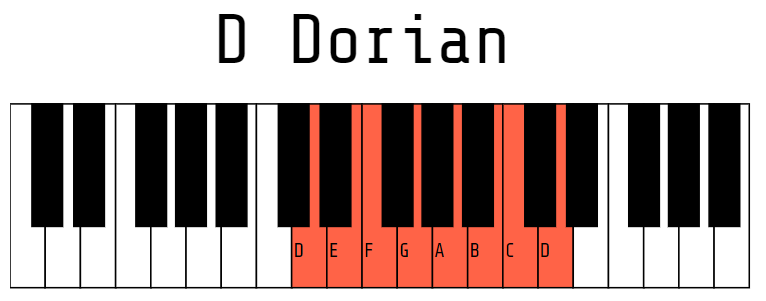Dorian scale (Dorian mode)
Dorian Mode Scale
The Dorian mode is a musical scale that is often associated with a minor sound but has a unique characteristic: a major sixth degree.
The formula for the Dorian mode scale is: T - S - T - T - T - S - T
- Start on any note (tonic)
- Move up a whole step (T)
- Move up a half step (S)
- Move up a whole step (T)
- Move up a whole step (T)
- Move up a whole step (T)
- Move up a half step (S)
- Move up a whole step (T)
For example, if we start on the note D, applying the formula gives us the D Dorian mode scale:
- D - E - F - G - A - B - C - D
The Dorian mode is often used in jazz, funk, and various other genres. It has a distinct sound and is characterized by its major sixth, which gives it a slightly brighter or more positive feel compared to a natural minor scale.

Dorian mode characteristics
The Dorian mode is a unique scale that stands out due to its distinctive interval pattern and the particular mood it creates.
Here are a few key aspects that make the Dorian mode special and differentiate it from other scales:
- Major 6th Degree: The Dorian mode is characterized by its major 6th degree, giving it a brighter, more uplifting quality compared to the natural minor scale.
- Modal Ambiguity: The Dorian mode is a "modal" scale derived from a parent major scale, creating a unique tonal center and modal flavor.
- Jazzy and Funky Feel: The Dorian mode is commonly used in jazz, funk, and fusion genres, providing a smooth, sophisticated, and slightly exotic feel.
- Harmonic Flexibility: The Dorian mode's interval pattern allows for interesting chord progressions and harmonizations, blending well with major and minor chords.
- Versatility: The Dorian mode can be found in various musical genres, adding depth and color to compositions in rock, pop, folk, and more.
Overall, the Dorian mode's unique qualities make it a favorite among musicians and composers seeking to explore different tonal flavors and evoke specific moods in their music.
Famous Songs in Dorian Mode
Here are a few examples of famous songs that utilize the Dorian mode:
- "Scarborough Fair" - Traditional English Ballad
- "Eleanor Rigby" - The Beatles
- "Oye Como Va" - Santana
- "So What" - Miles Davis
- "Riders on the Storm" - The Doors
- "Get Lucky" - Daft Punk
- "Stairway To Heaven" - Led Zeppelin
- "Woodstock" - Joni Mitchell
- "Another Brick In The Wall" - Pink Floyd
These songs incorporate elements of the Dorian mode either in their melodies, chord progressions, or improvisations. They demonstrate the versatility and richness of the Dorian mode in various musical genres.
Keep in mind that the Dorian mode might be present in certain sections of these songs or used as a basis for improvisation, rather than being the entire composition.
Chords in D Dorian Mode
Triads:
- Dm (D minor): D - F - A
- Em (E minor): E - G - B
- F (F major): F - A - C
- G (G major): G - B - D
- Am (A minor): A - C - E
- Bdim (B diminished): B - D - F
- C (C major): C - E - G
Quadriads:
- Dm7 (D minor 7): D - F - A - C
- Em7 (E minor 7): E - G - B - D
- Fmaj7 (F major 7): F - A - C - E
- G7 (G dominant 7): G - B - D - F
- Am7 (A minor 7): A - C - E - G
- Bm7b5 (B half-diminished 7): B - D - F - A
- Cmaj7 (C major 7): C - E - G - B
These chords are derived by stacking thirds (either major or minor) on each degree of the D Dorian mode. The resulting triads consist of three notes, while the quadriads consist of four notes.
Feel free to experiment with these chords to create chord progressions or use them as a starting point for your musical compositions.